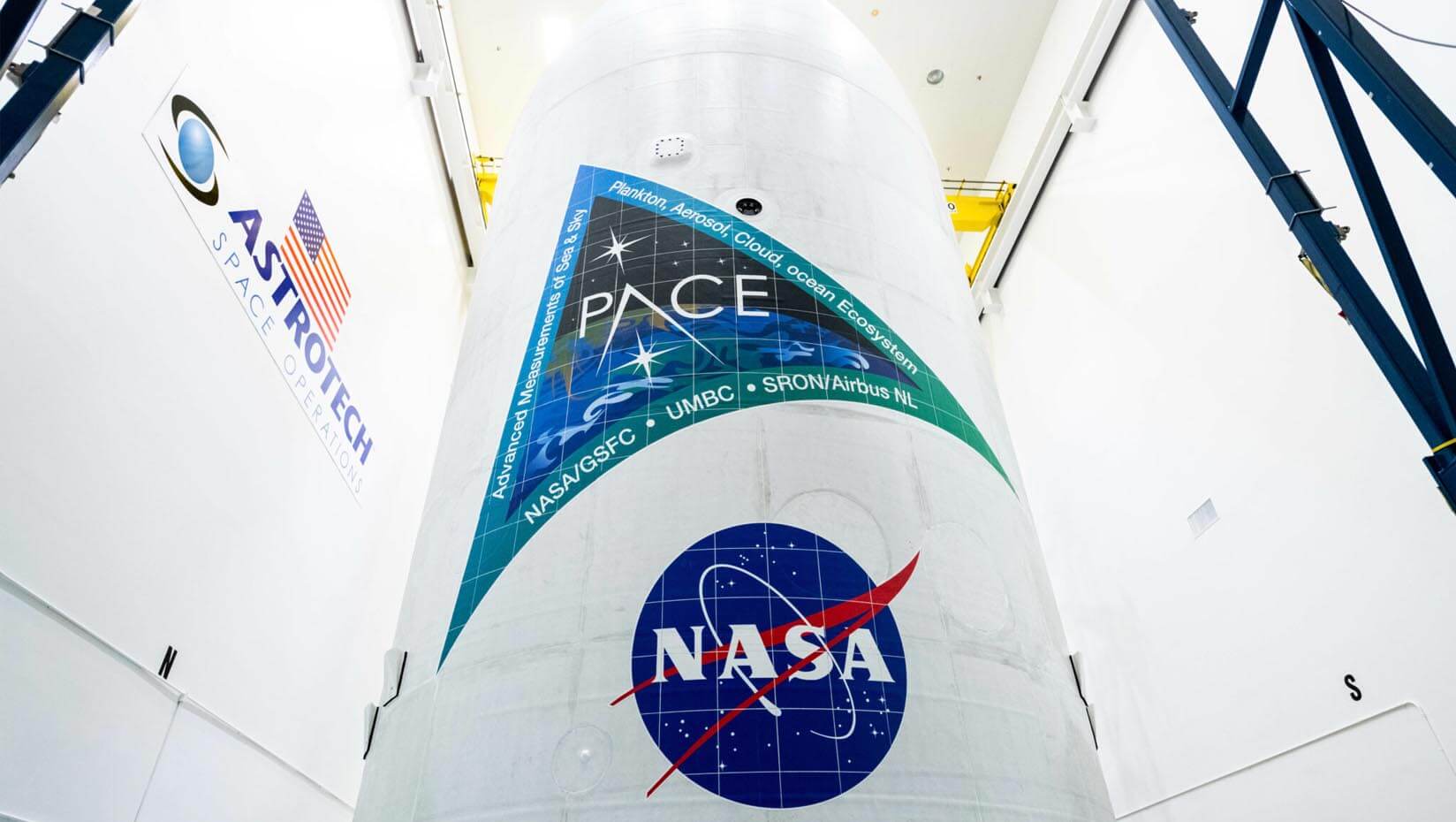
UMaine scientists aid NASA mission to study climate impact on oceans
On Feb. 8, Emmanuel Boss watched via livestream from Maine as 15 years of work culminated in a satellite launching into space aboard a SpaceX Falcon 9 rocket. Appearing as if enveloped in a ball of fire, the satellite jetted upward through the dark sky. It was 1:33 a.m.
“The vehicle continues to perform phenomenally. All nine engines firing,” the launch host said to the crowd gathered at Space Launch Complex 40 at Cape Canaveral Space Force Station in Florida. The voices of awed observers mingled with the rumble of the rocket until, finally, it faded from view.
The Plankton, Aerosol, Cloud, Ocean Ecosystem (PACE) mission is the latest effort by the National Aeronautics and Space Administration (NASA) to gain insight about carbon dioxide exchange between the ocean and the atmosphere. In addition to gathering more insight into that exchange, the PACE satellite, which Boss anxiously watched launch into space, will provide high-resolution, daily data on the ocean’s optical and polarization properties. This includes microscopic life in water, such as phytoplankton, and microscopic air particles.
At about 2 a.m., Boss received confirmation that the satellite had successfully reached orbit and was functional.
“The PACE satellite is special because it’s going to give us much more information than we’ve ever gotten before on the biology and biochemistry of the surface ocean,” Boss, professor of oceanography at the University of Maine, said.
A team of UMaine researchers and alumni, including Boss, played an integral role in the success of the PACE mission, working on the algorithms and systems to collect the data needed to calibrate and validate the satellite.
Boss and UMaine Ph.D. student Charlotte Begouen Demeaux collaborated on the algorithm development for PACE, while Boss worked with assistant research professor Nils Haentjens and others on the development and deployment of a system to vicariously calibrate the satellite’s radiometer, which measures the power of electromagnetic radiation. In collaboration with local colleagues, they have recently deployed two calibration systems, one in Crete, an island in Greece, and one in Puerto Rico. These systems will help offset minor calibration issues the radiometer on PACE may have as a result of the forces it experienced on its way to space.
“The beauty of satellites is they see the whole earth on a daily basis,” Boss said. “We get information about temperature, we get information about currents. We’re trying to build the image of how the ocean works. We have a pretty good image of how the physics of the ocean works — how it responds to wind, how it responds to rising temperature — but we have a very poor understanding of the response of ocean biology to the changes it is experiencing as a result of climate change.”
With the data this satellite collects, scientists worldwide and at UMaine can work toward identifying key factors that impact global warming. They can also pinpoint changes in ocean community composition and potentially create predictive models for monitoring ocean health.
“The idea is that by looking at the current state of the ocean and its response to various factors, you can determine how to create a reliable model to predict what’s going to happen later, which is a really hard thing to do,” Boss said.
Damian Brady, the Agatha B. Darling Professor of Oceanography at UMaine, is one of the researchers who worked with Boss on the PACE mission. He was one of several UMaine scientists in attendance in Florida when the PACE satellite was launched.
Brady’s work uses modern oceanographic tools such as satellite imagery to help communities make informed decisions around fisheries, aquaculture, energy and pollution. With PACE mission data, scientists such as Brady can determine the best locations to establish aquaculture based on food and oxygen availability. Brady’s work for the PACE satellite was focused primarily on finding new growing areas for oysters. He collaborated with postdoctoral research associate Tom Kiffney and Boss for this work.
UMaine connections extend even further: Jeremy Werdell, project scientist for the PACE mission and an oceanographer in the Ocean Ecology Laboratory at NASA Goddard Space Flight Center, received his Ph.D. from UMaine in 2014.
According to Boss, the practical implications of the information this satellite will deliver are numerous. Overfishing and releasing nutrients into coastal environments are two human-led activities that may affect ocean composition and that can be better informed by the data this satellite will gather. Harmful algal blooms (also known as toxic tides) are another example.
“In Maine, all the toxic tides are dealt with by sampling and doing some lab assays. If we can see these organisms from space, we can better say ‘look, this area is susceptible, you may want to test this faster than you do others,’” Boss said.
On March 8, NASA expects to receive the first round of data from the radiometer sensor on-board the PACE satellite, which Boss says he and his team will also be able to access.
“My mother asks me all the time: ‘how is the ocean doing?’ I tell her that bacteria are doing great,” Boss said. “There is no doubt that fish size is changing, communities of predators are changing, things are changing. And some of these are natural cycles. But some of them have to do directly with what we’re doing to the ocean. Understanding that is what we need in order to determine what is likely to happen in the ocean in 50 years if we don’t change the amount of CO2 we put in the atmosphere.”
Contact: Shelby Hartin, shelby.hartin@maine.edu
